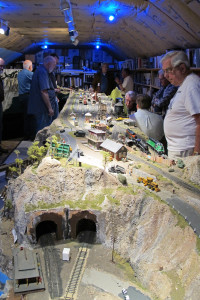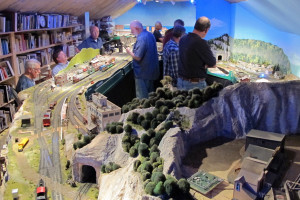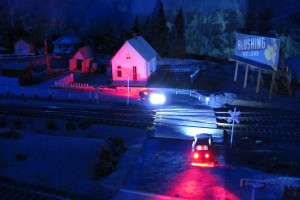By Al Carter / Photos by Al Frasch and Al Carter
For the June 2013 Skagit/Whidbey Clinic, the meeting was held at the home of Dick Haines, just north of Oak Harbor. Twenty Eight folks showed up to see Dick’s wonderful layout and enjoy his hospitality, not to mention a lot of great socializing among attendees.
Dick’s layout is unique in a couple of ways. First, it is in his attic, but this isn’t your normal attic. When Dick had his house built, he had the attic insulated and constructed with no supporting beams or other obstructions, and it has a nice, tall ceiling too – no stooping over, as in most attics! But, as with most attics, access is somewhat limited, via a pull-down stairway/ladder.
The second unique feature of Dick’s layout is his day-to-night lighting system. He has developed a method to transition from “daylight” to dusk to nighttime operations and he has really done a convincing job in this regard. “Nighttime” features include lots of building interior illumination, plus several vehicles with illuminated head and tail lights. And, of course, those headlights on locomotives are a must!
Dick had rigged up a small camera on a flat car that transmitted signals down to a television in his “crew lounge” area (the floor below the railroad), so those that were not actually upstairs could still see the action. It worked very well.
After a lot of folks had departed, Steve Jaffray hit upon the idea of adding a small LED flashlight to the top of the camera/flat car, and a train was run around the layout in darkness, with the flashlight illuminating the way. And the loco was being controlled by a DCC throttle from the second floor (the floor below the layout). Of course, one person was needed in the layout room “just in case” and occasionally, a pair of fingers could be seen reaching down from the “sky” to throw a switch.
If you were unable to attend the meeting at Dick’s and see his lighting effects first hand, you can read about it in the May-June issue of the Narrow Gauge and Short Line Gazette.
The next meeting for the group will be the annual August journey to Coupeville to see John Marshall’s garden layout, as we have done for the past couple of years. Watch for more details in a special, shortened edition of our newsletter.




No Comments Yet